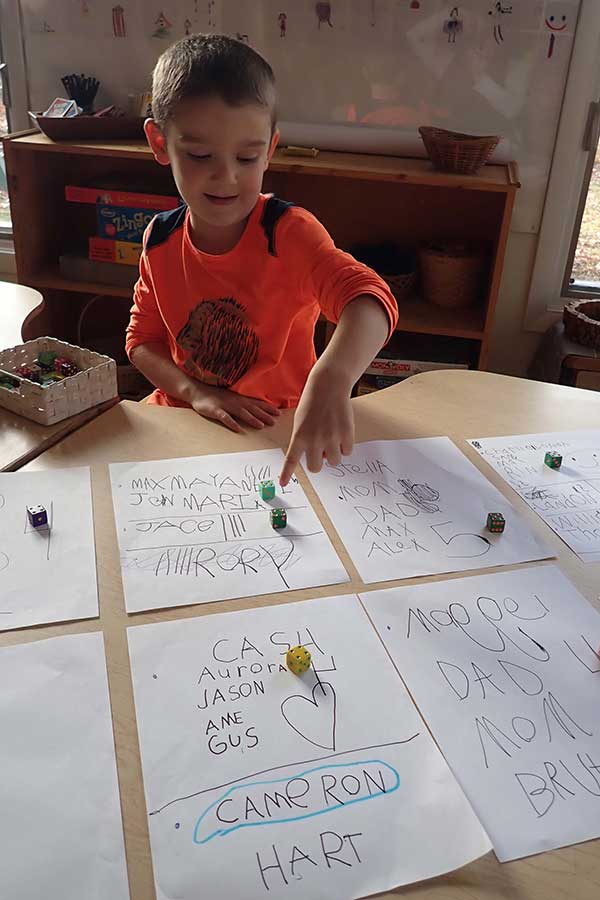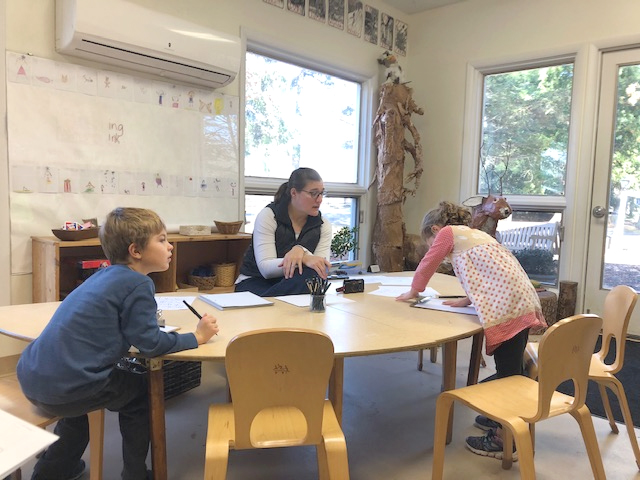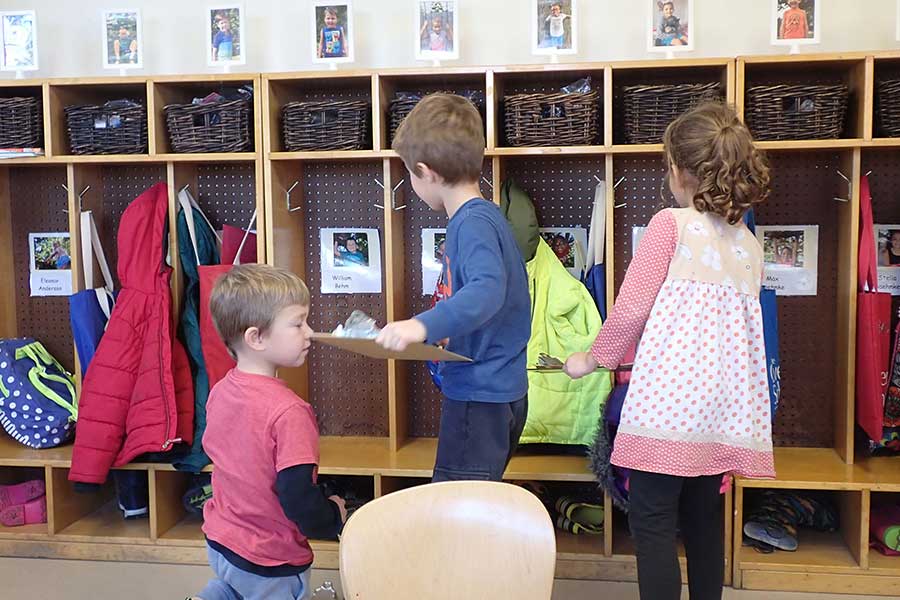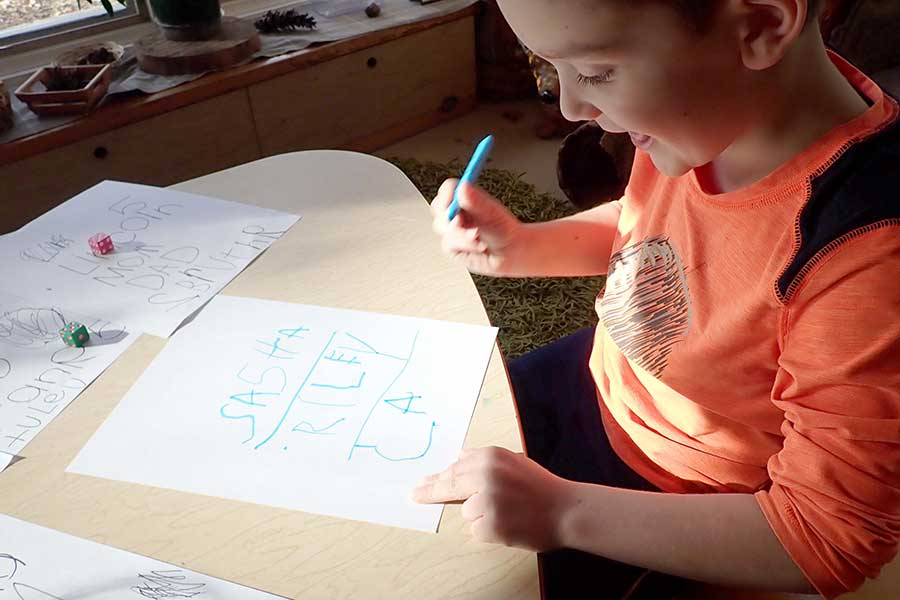Night Tree Treat Tracking
Developed by Laura Daehnke
The Overfield School
Language Arts, Mathematics, Visual Arts
Grade Level: Kindergarten
Introduction
Dr. Laura Berk, developmental psychologist states that, “…self-development begins with the dawning of self-awareness in infancy and evolves into a rich…organized view of the self’s characteristics and capacities during childhood and adolescence.” It is important for adults to work with very young children as they begin to understand the self as a separate entity. Teacher Laura Daehnke from the Overfield School used ideas that she learned during the 2019 Muse Machine Summer Institute to help her Kindergarteners learn about the concept of belonging. Using a team building tool, Laura helped her children construct a tool for tracking treats that they will make together for the animals that live on school grounds. The Night Tree sharing is a community event that is a long-standing occasion for the school, but Laura’s approach using the concept of belonging, is a new one that will likely be used for many years to come!
Click here to view/download this lesson plan as a PDFInspiration
At the 2019 Summer Institute for Educators, made possible by Muse Machine, Ping Chong + Company shared the topic of Identity, Belonging, and Sense of Place. Embedded in the “belonging” piece was the making of agreements and the use of team building exercises. This along with projects happening in our classroom inspired this lesson plan.




Overview
Summary
Students will share their theories of what it means to belong. Once there is an agreement on what belonging is, they will discuss ways to be sure everyone attending our upcoming Night Tree celebration has a treat to hang outside for the animals, thus being included and belonging. Students will develop a way to document the amount needed prior to the event, as well as, a way to track them as the treats are being made.
Standards
Visual Art Standards
- 1PE Describe the meaning in the marks they make on paper.
PE Explore their environments and experiences for artmaking ideas. - 2PR Generate ideas and images for artwork based on observations, memory, imagination and experience.
- 2RE Show confidence and pride in their artistic accomplishments.
- 6RE Recognize and point out the similarities and differences between artistic styles.
Math Standards
- K.CC.A.1 Count to 100 by ones and by tens.
- K.CC.A.2 Count forward beginning from a given number within the known sequence (instead of having to begin at 1).
- K.CC.A.3 Write numbers from 0 to 20. Represent a number of objects with a written numeral 0-20 (with 0 representing a count of no objects).
- K.CC.A.4 Understand the relationship between numbers and quantities; connect counting to cardinality.
Language Arts Standards
- S.L.K.1 Participate in collaborative conversations with diverse partners about kindergarten topics and texts with peers and adults in small and larger groups.
- S.L.K.3 Ask and answer questions in order to seek help, get information, or clarify something that is not understood.
Objectives/Outcomes
The children will come to an agreement on what belonging means. Using this agreement, the children will figure out how many treats are needed for our class’s upcoming Night Tree celebration. They will then find a way to document the amount of treats we complete as they are being made over the next few weeks. A plan for this way of tracking will be made and if time permits, the actual structure will be made.
Teaching Approach
Co-creating and facilitating student-led activities
Assessment
Teacher will join the small group to facilitate discussion. Teacher will take notes and record observations as the children come to agreements and share their ideas. Teacher will assist in providing the necessary materials to make plans and potentially a chart for tracking. Teacher will also take notes on the number sense of each child as they work together on the latter portion.
Lesson Preparation
Teacher Needs
- Table for small group of children
- Notebook and pen for documentation
- Paper and Pens for the children
- Clipboards
- Large paper and Markers, if they get the actual Chart
- Belonging Pennant
Click here for Pinterest: Belonging Activities
Some more ideas for helping set the scene for “belonging” with very young children!
Helpful Hints
- Be prepared to counter the question of what it means to belong with, “What does it mean to not belong?”
- Decide whether each child can document independently or if there needs to be one way of doing so.
Student Needs
Prior Knowledge
Children will need to understand what Night Tree looks like and why we are making treats at all. They will also need some understanding of how a conversation works.
Student Voice
Students will offer theories on what it means to belong. They will share their ideas on how to determine the number of treats needed. They will also share and agree on a way to track the treats.
Vocabulary
- Belong: include everyone equally
- Night Tree: a celebration in December where families come to school. While there, the Night Tree by Eve Bunting is read, holiday songs are sung and the children and their families hang treats on the trees outdoors for the animals to eat. The families are then welcome to enjoy hot chocolate and treats indoors.
- Treats: pinecones rolled in bird seed; cereal, apple pieces, cranberries and popcorn strung, oranges sliced and strung
- Track: a way to keep a count of how many treats we have and how many more are needed
Evidence/Assessment of Outcomes
The students will show through conversation their understanding of what it means to belong. They will share their ideas with others, as well as, listen to their peers. Together they will work through these ideas as a way of coming to an agreement or shared definition of the word. The students will discuss and work together to figure out how many treats our K-2 classes need. They will then formulate a plan (either verbally or through drawing) of how to track the number of treats being made.
Enduring Understandings
- Sharing ideas and listening to others is a way to rethink your own ideas. This allo ws you to evaluate your own thinking and either make changes as you hear from others, or hold firm to your own ideas.
- Drawing is another method that can be used to share thoughts and ideas.
- Interviewing and recording data will help you learn new things and retain said information.
- Charts can be used in progress or as a way to show information at the end.
Learning Plan
Prompt
As you know, our Night Tree celebration is only 10 school days away. Our decorations have to be finished in 7 days, but we have a few extra to complete the treats that we’ll all get to hang on the trees for the animals.
Hooks
Before we think about making treats, I want us to think about a special word…. BELONG. Use the family pennant to help the students understand what BELONG means in the context of this lesson.
Essential Questions
- What does it mean to belong?
- What does it mean to NOT belong?
- How do you know if you belong?
Resources
- Images of previous Night Tree treats
- Paper, Pens, Clipboards
- Access to each child’s name (Lockers)
Teacher and Student Performance Tasks
- Teacher says, “As you know, our Night Tree celebration is only 10 school days away. Our decorations have to be finished in 7 days, but we have a few extra to complete the treats that we’ll all get to hang on the trees for the animals. Before we think about making treats, I want us to think about a special word….BELONG. What does it mean to belong?”
- The children begin a discussion on their understanding. Perhaps they will all agree immediately, or perhaps they will have some back and forth. The teacher will facilitate the conversation as needed to help the children with the art of communicating as a way to help them come to an agreement on what it means to belong.
- If they are struggling, try asked what is means to NOT belong, how it feels to not belong or how one knows whether or not they belong.
- “Now that we all agree on what it means to belong, we need to think about Night Tree treats. We want everyone to feel like they belong at Night Tree and therefore we will need enough treats for everyone who comes. I’m wondering if we can figure out how many people might be at our K-2 Night Tree…”
- The children will share ideas on how to collect this data. Decide if this data can be collected independently or whether the entire groups needs to go about it in the same manner.
- The data will then be added together to get a grand total.
- “As we make the treats, how will we be able to keep track of how many we have? We can’t keep re-adding the treats every time we make a new one…”
- The children will discuss ways to track the treats. They will converse to make a plan for their agreed upon way of tracking.
- If time allows, they will begin following their plan.
Final Review
Students will share their chart/tracking method with the entire class, explaining how to use it so that everyone can do so on their own. The children will show understanding by following the directions and filling in the tracking device throughout the next 10 school days.
Lesson Reflection
The word belong has multiple meanings. I was hoping they would define it as including everyone, but instead they were more focused on the word in terms of ownership, like “My toys belong to me.” Had I flipped the question and asked, “What does it mean to NOT belong, would they have come up with the definition I was hoping for? Children’s literature could have helped define, as well.”
That would have been a good time to write the word on the board and add each child’s description around it, forming a web of sorts.
I was pleased with the idea of using dice to help add each number together, which was entirely an idea from the children.
As it turned out, we needed to have 91 treats for the celebration and were able to produce 116!



